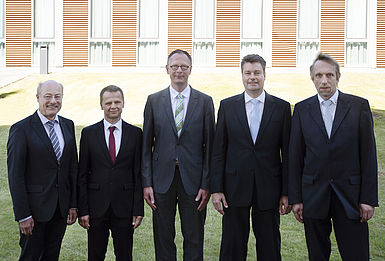Please type a search term (at least two characters)
News
EMPIR project partners win Helmholtz prize

EMPIR project partners PTB have been awarded the 2018 Helmholtz prize for work on the accurate measurement and generation of small currents.
The excellence of science research in EURAMET projects was recently recognised with the awarding of the 2018 Helmholtz prize for “Precision Measurements in Applied Measurement Technology” for work in current European Metrology Programme for Innovation and Research joint research project ‘Quantum realisation of the SI ampere’ (15SIB08).
The prize
The Helmholtz Prize, awarded every two to three years, is a token of the highest recognition for scientists for precision measurements in physics, chemistry and medicine.
The scientists
Scientists from PTB working on the project were identified for their contribution to the field of small current measurement through the development of a novel current amplifier, the Ultrastable Low-noise Current Amplifier (ULCA).The scientists from PTB were Dietmar Drung, Martin Götz, Eckart Pesel and Hansjörg Scherer.
The project: Quantum realisation of the SI ampere
The ampere is the base unit of electrical current in the International System of units (known as the SI). At present it is formally defined by mechanical forces between wires. This is to be replaced later this year by a more robust definition based on the quantisation of charge. This change is part of a wider redefinition of the SI units expected to be approved in November this year. These changes are highly technical, and not expected to have immediate consequences to those outside the measurement science community.
The three year project, which started in 2016, aims to develop new ways to create and disseminate precision electrical current standards based on fundamental constants.
The amplifier
The ULCA uses a circuit design engineered for extremely high measurement stability. This results in improved current calibration and measurement capabilities which have an impact upon a range of industries where small current measurements are critical, such as semiconductor testing, environmental measurement, DNA sequencing and quantum communication.
The ULCA plays a key role in research on single-electron circuits giving a quantum realisation of the new ampere, the aim of the e-SI-Amp project. As the device is stable and portable, transport of units between partners is possible, enabling international comparisons of measurement systems.
The ULCA is commercially available from Magnicon, under licence from PTB.
The e-SI-Amp project is part of EURAMET’s European Metrology Programme for Innovation and Research (EMPIR).
This EMPIR project is co-funded by the European Union's Horizon 2020 research and innovation programme and the EMPIR Participating States.
Carbon dioxide, released from man-made activities, is lowering the pH of the Earth’s oceans, and impacting the health of marine organisms worldwide more
Supporting automated and reconfigurable manufacturing systems more
Working with external project Cool White to test and suggest improvements on the locally available white paints more
The project FutureEnergy has provided new calibration services for ultra-high voltages and a good practice guide on Lightning Impulse dividers more
For many of the 5000 photonics companies in Europe a precise knowledge of a material’s optical properties is vital for industrial competitiveness more





